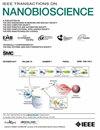通过血管分子通信的无线体区纳米网络
IF 4.4
4区 生物学
Q1 BIOCHEMICAL RESEARCH METHODS
引用次数: 0
摘要
生物技术和分子通信的进步使得纳米机械在无线体域网络(WBAN2)中的应用成为可能,例如药物输送、癌症检测和紧急救援服务。要有效地研究这些网络,必须建立一个理想的传播模型,其中包括每对同程纳米机器之间的信道响应,并考虑到每个接收节点收到的干扰。在本文中,我们采用平流-扩散方程来获得通过血管 WBAN2 的确定性信道矩阵。此外,我们还推导出了全双工(FDX)和半双工传输(HDX)模式下符号间干扰(ISI)和同信道干扰(CCI)的闭合形式。通过应用这些确定性公式,我们提出了理想信道模型和干扰的随机等价物,通过同时纳入 CCI、ISI 和背景噪声,提供了一种创新的通信模型。最后,我们通过大量实验对结果进行评估,并使用信号干扰加噪声比(SINR)和容量作为衡量标准。本文章由计算机程序翻译,如有差异,请以英文原文为准。
Wireless Body Area Nanonetworks via Vascular Molecular Communication
Advancements in biotechnology and molecular communication have enabled the utilization of nanomachines in Wireless Body Area Networks (WBAN2) for applications such as drug delivery, cancer detection, and emergency rescue services. To study these networks effectively, it is essential to develop an ideal propagation model that includes the channel response between each pair of in-range nanomachines and accounts for the interference received at each receiver node. In this paper, we employ an advection-diffusion equation to obtain a deterministic channel matrix through a vascular WBAN2. Additionally, the closed forms of inter-symbol interference (ISI) and co-channel interference (CCI) are derived for both full duplex (FDX) and half duplex transmission (HDX) modes. By applying these deterministic formulations, we then present the stochastic equivalents of the ideal channel model and interference to provide an innovative communication model by simultaneously incorporating CCI, ISI, and background noise. Finally, we evaluate the results with numerous experiments and use signal-to-interference-plus-noise ratio (SINR) and capacity as metrics.
求助全文
通过发布文献求助,成功后即可免费获取论文全文。
去求助
来源期刊

IEEE Transactions on NanoBioscience
工程技术-纳米科技
CiteScore
7.00
自引率
5.10%
发文量
197
审稿时长
>12 weeks
期刊介绍:
The IEEE Transactions on NanoBioscience reports on original, innovative and interdisciplinary work on all aspects of molecular systems, cellular systems, and tissues (including molecular electronics). Topics covered in the journal focus on a broad spectrum of aspects, both on foundations and on applications. Specifically, methods and techniques, experimental aspects, design and implementation, instrumentation and laboratory equipment, clinical aspects, hardware and software data acquisition and analysis and computer based modelling are covered (based on traditional or high performance computing - parallel computers or computer networks).
 求助内容:
求助内容: 应助结果提醒方式:
应助结果提醒方式:


